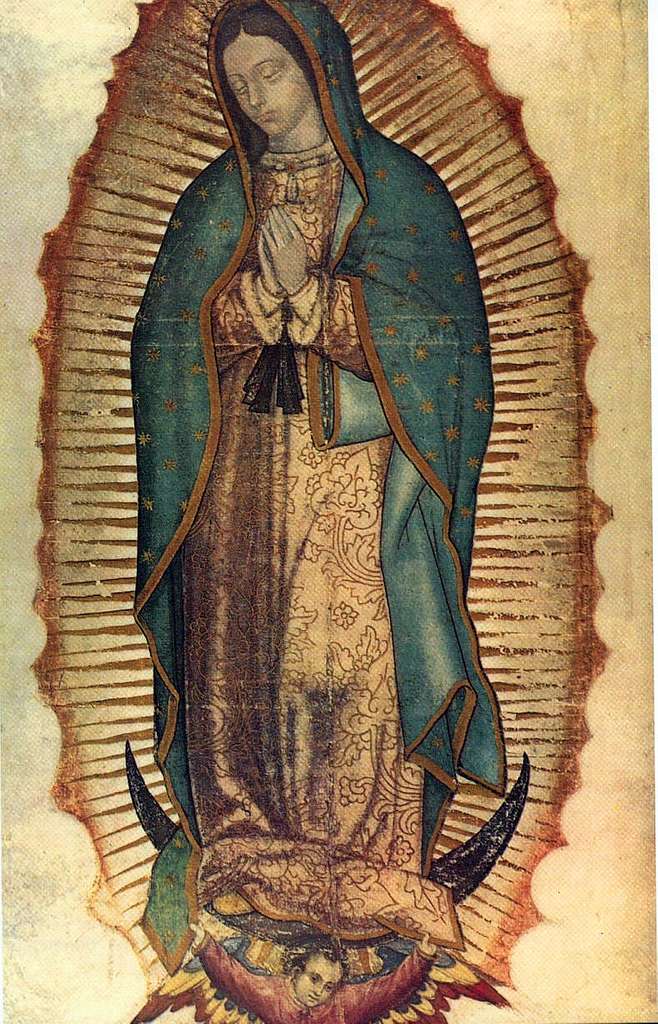Our Lady of Guadalupe
Our Lady of Guadalupe, also known as the Virgin of Guadalupe or La Virgen de Guadalupe in Spanish, is one of the most revered and iconic religious figures in Mexican and Latin American culture. She holds a significant place in the Catholic faith and is the patroness of the Americas.

In December 9, 1531, a peasant named Juan Diego (now Saint Juan Diego) encountered the Virgin Mary on the Hill of Tepeyac, near Mexico City. The Virgin Mary appeared to Juan Diego as a young indigenous woman, speaking to him in his native Nahuatl language.
During the encounter, the Virgin Mary instructed Juan Diego to go to the bishop and request the construction of a church in her honor at the site. However, the bishop was skeptical and asked for a sign to prove the authenticity of Juan Diego's vision. In response, the Virgin Mary appeared to Juan Diego again, instructing him to gather roses from the hilltop – roses that were themselves miraculous, as it was winter and no flowers should have been growing there. She arranged the roses in his cloak, or tilma, and told him not to open it until he reached the bishop.
When Juan Diego presented the roses to the bishop and opened his cloak, an image of the Virgin Mary was miraculously imprinted on the fabric. This image, known as the "Virgin of Guadalupe," became a powerful symbol of faith and devotion for the Mexican people and the Catholic Church.
The image of Our Lady of Guadalupe is a young woman dressed in traditional Mexican attire, standing on a crescent moon with rays of sunlight surrounding her. She is depicted with hands clasped in prayer and her eyes looking downward in a posture of humility and compassion. Diego's tilma is displayed in the Basilica of Our Lady of Guadalupe in Mexico City, one of the most visited Catholic pilgrimage sites in the world.
There are numerous aspects of the tilma image that are inexplicable by natural science, despite numerous tests and investigations. When fibers of the fabric were studied, they were found to contain no dye – although they were clearly colored with the image of Our Lady. But scientists could find no traces of any kind of animal, vegetable, or mineral coloring. The fabric itself also seems to have unnatural longevity. Despite its age and the fact that it has been on display for hundreds of years, it is still in excellent condition. It has resisted light and insect damage and even survived an accidental acid spill – in the late 1795, nitric acid was spilled on the upper right side of the cloth. Although a small mark is still visible, the damage is much more minimal than would be expected from a spill of that nature. The fabric is even said to maintain a temperature between 97.8°F and 98.6°F – the normal temperature of a human body. These are just some of the miracles associated with the tilma and the image of Mary that it bears.
The devotion to Our Lady of Guadalupe extends beyond Mexico and has spread throughout the Americas and beyond. She is revered as a symbol of unity, protection, and hope. Her image is associated with numerous miracles and has been credited with bringing about conversions to the Catholic faith.
The feast day of Our Lady of Guadalupe is celebrated on December 12 each year, marking the anniversary of Juan Diego's final encounter with the Virgin Mary and the miraculous image on his tilma. On this day, millions of pilgrims from Mexico and around the world travel to the Basilica of Our Lady of Guadalupe to honor her and seek her intercession.
Our Lady of Guadalupe holds immense cultural and religious significance, serving as a unifying figure across diverse communities and embodying the deep devotion and faith of millions of people.
Updated 06-07-2023